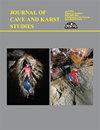新墨西哥州桑多瓦尔县Ojito荒野上白垩纪达科他组pagate成员的不寻常痕迹化石组合
IF 0.5
4区 地球科学
Q4 GEOSCIENCES, MULTIDISCIPLINARY
引用次数: 0
摘要
最近,在对新墨西哥州桑多瓦尔县圣伊西德罗附近的Ojito荒野的白垩纪地层进行古生物学调查时,发现了一块上白垩纪(塞诺曼尼亚)达科他组帕格特成员的砂岩板,其表面保存着极不寻常的岩石组合。砂岩层厚0.1 ~ 0.3 m,为中粒石英。它在有迹化石的表面有对称的波纹,来自帕格特段底部以上3 m的地层水平。这些痕迹是:(1)丰富的海assinoides形成分支的多边形网络;(2)克鲁齐亚纳的几条小径;(3)植藻类4种;(4)马蹄蟹行走轨迹下沉降区。一些海鞘纲与Cruziana和Zoophycos的一个痕迹相交,因此这表明至少有两段痕迹形成。这个来自帕格特段的鱼类组合显然是保存在一个浅的、含氧良好的海洋环境中,或略高于波基。事实上,该组合可以很容易地归属于克鲁齐亚纳海相,这是浅海环境的特征。尽管如此,植生藻长期以来被认为是深海和/或缺氧海水的标志,因此它在典型的克鲁齐亚纳鱼相痕迹中是“不合适的”。因此,pagate岩相组合表明植藻属是一种不应与原型岩相相联系的交叉岩相分类单元。本文章由计算机程序翻译,如有差异,请以英文原文为准。
Unusual trace fossil assemblage from the Upper Cretaceous Paguate Member of the Dakota Formation in the Ojito Wilderness, Sandoval County, New Mexico
A recent paleontological inventory of Cretaceous strata in the Ojito Wilderness near San Ysidro, Sandoval County, New Mexico, discovered a slab of sandstone of the Upper Cretaceous (Cenomanian) Paguate Member of the Dakota Formation with a highly unusual ichnoassemblage preserved on the surface . The sandstone is a 0.1 to 0.3 m thick bed that is medium-grained and quartzose. It has symmetrical ripples on the trace-fossil-bearing surface and is from a stratigraphic level ~ 3 m above the base of the Paguate Member. The traces are: (1) abundant Thalassinoides that form branching, polygonal networks; (2) several trails of Cruziana ; (3) four specimens of Zoophycos; and (4) an area with undertrack fallout of the horseshoe crab walking trace Kouphichnium . Some Thalassinoides crosscut Cruziana and one of the Zoophycos traces, so this suggests at least two episodes of trace formation. This ichnoassemblage from the Paguate Member clearly was preserved in a shallow, well oxygenated marine setting at or slightly above wave base. Indeed, the assemblage can readily be assigned to the Cruziana ichnofacies, which is characteristic of shallow marine settings. Nevertheless, Zoophycos has long been accepted as an indicator of deep and/or poorly oxygenated marine waters, so it is “out of place” among traces typical of the Cruziana ichnofacies. The Paguate ichnoassemblage thus presents evidence that Zoophycos is a facies crossing ichnotaxon that should not be associated with an archetypal ichnofacies.
求助全文
通过发布文献求助,成功后即可免费获取论文全文。
去求助
来源期刊

Journal of Cave and Karst Studies
地学-地球科学综合
CiteScore
1.90
自引率
0.00%
发文量
6
审稿时长
>12 weeks
期刊介绍:
The Journal of Cave and Karst Studies is a multidisciplinary journal devoted to cave and karst research. The Journal is seeking original, unpublished manuscripts concerning the scientific study of caves or other karst features. Authors do not need to be members of the National Speleological Society, but preference is given to manuscripts of importance to North American speleology.
 求助内容:
求助内容: 应助结果提醒方式:
应助结果提醒方式:


